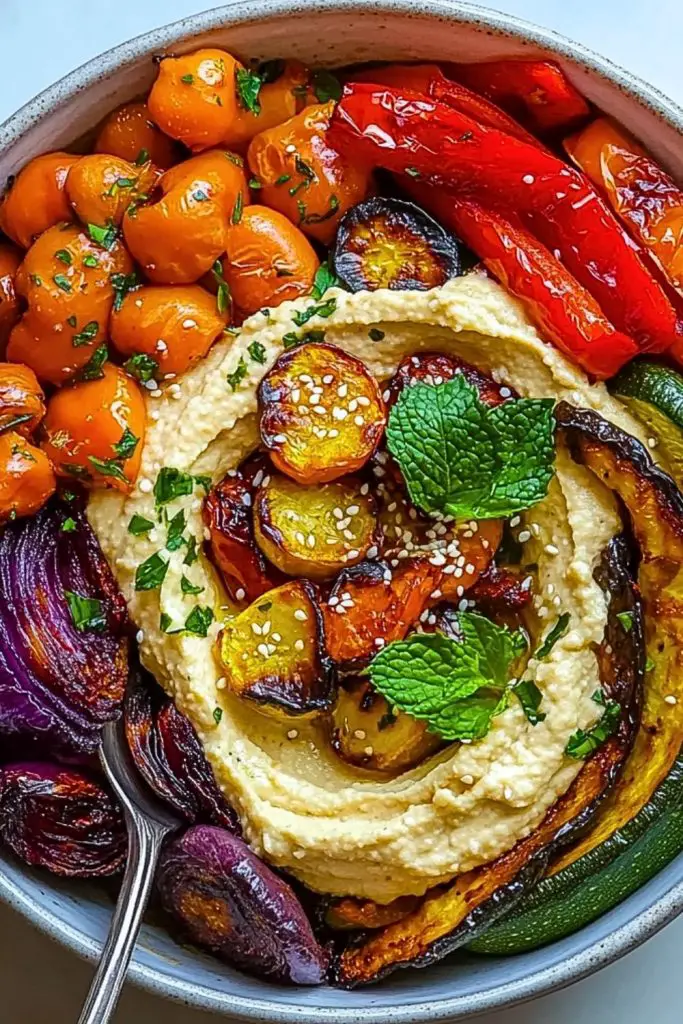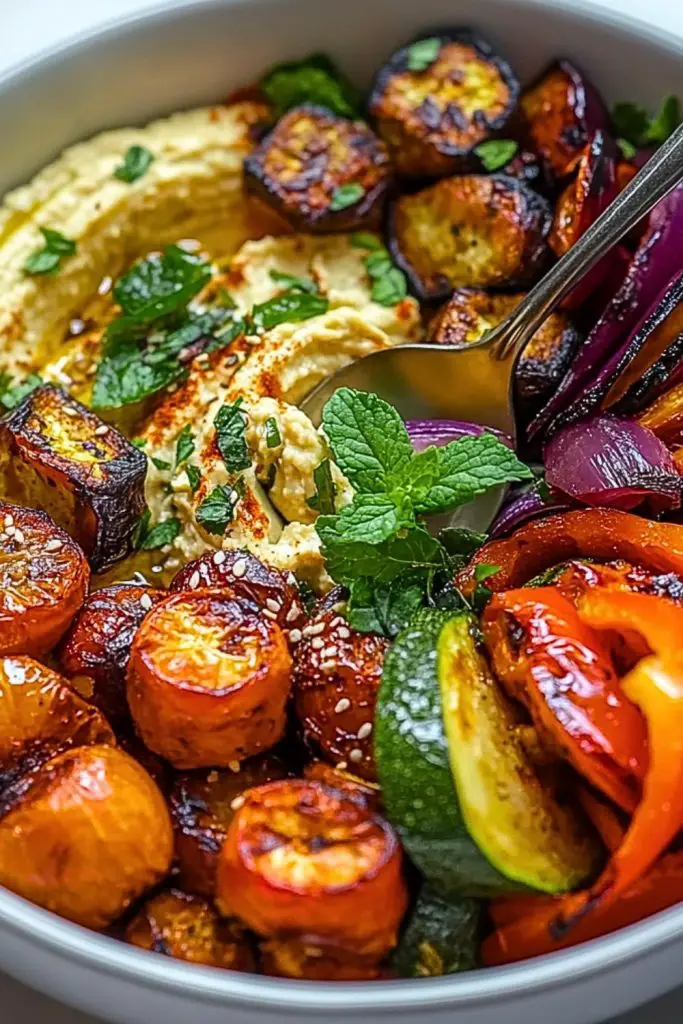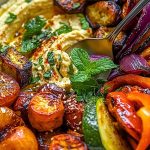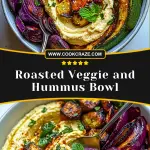Few dishes strike a balance between nourishment, color, and comfort like a Roasted Veggie and Hummus Bowl. This vibrant creation is more than a meal—it’s an artful expression of plant-based harmony. With smooth, creamy hummus as the anchor, the bowl becomes a canvas for richly caramelized vegetables: sweet carrots, smoky bell peppers, tender zucchini, purple onions, and golden baby potatoes all roasted to coax out their deepest flavor.

Every forkful is a blend of creamy, earthy, and zesty flavors, with added texture from a sprinkle of sesame seeds and the refreshing lift of fresh mint. Whether you’re looking for a healthy lunch or a satisfying vegan dinner, this bowl makes whole foods feel indulgent.
Why You’ll Love This Roasted Veggie and Hummus Bowl
- Visually Stunning: A beautiful medley of vibrant vegetables in one bowl.
- Plant-Based Power: Rich in fiber, antioxidants, and protein-packed thanks to the hummus and chickpeas.
- Customizable: Swap in whatever seasonal vegetables you have on hand.
- Meal-Prep Friendly: Pre-roast your veggies and keep hummus ready in the fridge.
- Balanced and Satisfying: The mix of textures and flavors keeps every bite interesting.
- Gluten-Free & Vegan: Naturally accommodates a variety of dietary needs.
Preparation Phase & Tools to Use (Essential Tools and Equipment, and Their Importance)
Crafting the perfect Roasted Veggie and Hummus Bowl begins with the right tools to elevate each element—from roasting to blending. Here’s what you’ll need:
- Baking Sheets: Crucial for evenly roasting a variety of vegetables without crowding. Use two if needed.
- Parchment Paper or Silicone Baking Mats: Helps prevent sticking and makes cleanup easier.
- Sharp Chef’s Knife: Vital for clean, uniform vegetable cuts to ensure even roasting.
- Cutting Board: Preferably wooden or plastic with grip, to keep prep safe and efficient.
- Blender or Food Processor: Essential for creating ultra-smooth homemade hummus.
- Large Mixing Bowl: Useful for tossing vegetables with oil and seasoning.
- Measuring Cups & Spoons: Accuracy matters for consistent hummus flavor.
- Serving Bowls: Choose shallow, wide bowls for easy layering and beautiful presentation.
Preparation Tips
- Chop Uniformly: Keep vegetable sizes consistent so they roast evenly.
- Dry Veggies Before Roasting: Moisture leads to steaming, not caramelizing—pat your veggies dry after washing.
- Use High Heat (around 425°F/220°C): Encourages browning and crisp edges without overcooking the inside.
- Don’t Overcrowd the Pan: Spread vegetables in a single layer for the best roast.
- Homemade Hummus Tip: Peel chickpeas (if you have time) for the creamiest texture.
- Season Generously: Olive oil, salt, pepper, and a touch of cumin or smoked paprika enhance flavor without overpowering.
- Fresh Garnishes Make a Difference: Mint, parsley, or lemon zest brighten up the finished dish.
Ingredients for This Roasted Veggie and Hummus Bowl
Here’s what you’ll need to build this delicious and wholesome bowl. The ingredients are divided into two main parts: roasted vegetables and homemade hummus.
For the Roasted Vegetables:
- 2 carrots, peeled and sliced into coins
- 1 red bell pepper, sliced into strips
- 1 yellow bell pepper, sliced into strips
- 1 zucchini, halved lengthwise
- 1 small eggplant or squash, cut into thin wedges
- 1 red onion, quartered
- 1 cup cherry tomatoes or roasted chickpeas
- 2 tbsp olive oil
- Salt & freshly ground pepper, to taste
- 1/2 tsp smoked paprika
- 1/2 tsp cumin (optional)
For the Hummus (or use your favorite store-bought version):
- 1 ½ cups cooked chickpeas (or 1 can, drained and rinsed)
- ¼ cup tahini
- 2 tbsp olive oil
- 2 tbsp lemon juice
- 1 garlic clove, minced
- ¼ tsp ground cumin
- Salt to taste
- 2–4 tbsp cold water, to blend until smooth
For Garnish:
- Fresh mint leaves or parsley, chopped
- Toasted sesame seeds
- A drizzle of olive oil or balsamic glaze (optional)

Step-by-Step Instructions for Roasted Veggie and Hummus Bowl
This dish comes together in a series of easy, rewarding steps. Follow along to layer each component with care and flavor.
Step 1: Preheat and Prep
Preheat your oven to 425°F (220°C). Line one or two baking sheets with parchment paper or silicone baking mats. While the oven heats, wash and prep your vegetables—slicing the carrots, peppers, onion, zucchini, and eggplant into uniform sizes for even roasting.
Step 2: Season and Roast Vegetables
Place all your chopped vegetables and chickpeas or cherry tomatoes in a large bowl. Drizzle with olive oil, and sprinkle with salt, pepper, smoked paprika, and cumin (if using). Toss well to coat everything evenly.
Spread the vegetables in a single layer on the baking sheets. Roast for 25–30 minutes, flipping once halfway through, until golden and slightly charred at the edges.
Step 3: Make the Hummus
While the veggies roast, prepare your hummus. In a food processor or high-speed blender, combine chickpeas, tahini, lemon juice, olive oil, garlic, cumin, and salt. Blend until smooth, adding cold water a tablespoon at a time until you reach your desired creamy consistency. Taste and adjust seasoning as needed.
Step 4: Assemble the Bowl
Spoon a generous amount of hummus into each serving bowl and swirl it gently with the back of a spoon. Arrange the roasted vegetables around the hummus in vibrant sections.
Top with fresh mint or parsley, a sprinkle of toasted sesame seeds, and an optional drizzle of olive oil or balsamic glaze for added richness.
Step 5: Serve and Enjoy
Serve immediately while the vegetables are warm and the hummus is creamy. Each bite should combine textures and flavors—smooth, crispy, earthy, and refreshing.
Notes
- Homemade vs Store-Bought Hummus: While homemade hummus gives you full control over texture and seasoning, store-bought varieties are perfectly acceptable for a quicker version. Choose one with simple, clean ingredients.
- Roasting Time Varies: Keep an eye on your vegetables—thin slices of zucchini and peppers roast faster than root vegetables like carrots or potatoes.
- Make It a Meal Prep Hero: Roast a double batch of veggies and store separately. Build bowls in minutes during the week.
- Add Grains for Heft: For a heartier bowl, layer in quinoa, farro, or couscous underneath the hummus.
- Spice it Up: Add a touch of harissa, chili flakes, or dukkah for more punch if you enjoy heat.
Watch Out for These Mistakes While Cooking
- Overcrowding the Baking Tray
This causes steaming instead of roasting. Spread the veggies out to let them caramelize properly. - Underseasoning
Don’t shy away from spices and salt—veggies need bold seasoning to shine against the neutral base of hummus. - Skipping the Flip
Failing to flip the vegetables halfway through roasting can lead to uneven charring and soggy sides. - Watery Hummus
Be conservative with water at first when blending hummus. Add slowly to keep control over texture. - Serving Cold
While hummus can be served cool, the roasted vegetables are best warm for full flavor. Don’t let them sit too long after roasting. - Using Low-Quality Olive Oil
A rich, high-quality olive oil makes a huge difference in both the hummus and drizzling for finish.
What to Serve With Roasted Veggie and Hummus Bowl?
Though the bowl is satisfying on its own, complementing it with a side or drink can elevate your meal into something even more special. Whether you’re hosting or meal prepping, here are ideas to round out your plate.
8 Recommendations:
- Warm Pita Bread or Flatbread
Perfect for scooping up hummus and roasted veggies—chewy, soft, and simple. - Lemon Couscous or Herbed Quinoa
Add a fluffy, grain-based side to bring extra heartiness to your meal. - Greek Yogurt Tzatziki (or vegan version)
Its tangy, cooling contrast is refreshing against the roasted depth of the veggies. - Marinated Olives or Pickled Veggies
Salty and sharp additions balance the rich and creamy hummus. - Stuffed Grape Leaves (Dolmas)
These Mediterranean treats are a flavorful finger food and pair well with everything in the bowl. - Simple Green Salad with Lemon Dressing
Light, crisp, and citrusy—an ideal way to add crunch and freshness. - Chickpea Fritters or Falafel
Add protein and crunch while keeping the dish fully plant-based. - Mint Iced Tea or Sparkling Citrus Water
Hydrating and zesty drinks that cleanse the palate between bites.
Storage Instructions
A Roasted Veggie and Hummus Bowl stores beautifully, making it ideal for weekly meal prep or leftovers.
- Roasted Vegetables:
Store in an airtight container in the refrigerator for up to 4–5 days. Reheat in the oven or a skillet to revive their texture—avoid the microwave if you want to keep them crisp. - Hummus:
Homemade hummus keeps well for 5–7 days in the fridge. Store in a sealed container, and top with a thin layer of olive oil to help preserve freshness. Stir before serving. - Assembled Bowls:
If pre-assembled, keep them in airtight meal-prep containers for up to 3 days. Best served slightly warm or at room temperature. Store garnishes like mint separately to maintain freshness. - Freezing Tips:
Hummus freezes well for up to 3 months. Thaw overnight in the fridge and stir well before serving. Roasted vegetables can be frozen, but their texture may change upon thawing—use for soups or grain bowls.
Estimated Nutrition (Per Serving)
Note: Values may vary based on portion size and ingredients used.
- Calories: ~420 kcal
- Protein: 12–14g
- Carbohydrates: 38–45g
- Dietary Fiber: 10–12g
- Sugars: 7g
- Fat: 22–26g
- Saturated Fat: 3g
- Cholesterol: 0mg
- Sodium: 400–500mg
- Vitamin A/C/Iron: High source depending on vegetable variety
Frequently Asked Questions
1. Can I use store-bought hummus instead of homemade?
Yes, absolutely. Store-bought hummus is a convenient alternative—just choose one with clean, simple ingredients and minimal additives.
2. Which vegetables roast best for this bowl?
Sturdy veggies like carrots, bell peppers, zucchini, eggplant, onions, and even cauliflower work great. Feel free to rotate based on what’s in season.
3. How do I make this bowl spicier?
Add harissa, crushed red pepper flakes, or a dash of cayenne to your veggie seasoning or hummus. A drizzle of spicy chili oil also adds heat and depth.
4. Is this recipe gluten-free?
Yes! The entire bowl is naturally gluten-free. Just ensure any sides (like bread or falafel) are made with gluten-free ingredients if needed.
5. What protein options can I add?
Aside from chickpeas, try grilled tofu, tempeh, or a poached egg for extra protein. Chicken or salmon can also be added for non-vegetarian versions.
6. How can I make this dish oil-free?
Roast vegetables on parchment paper without oil and make your hummus without olive oil—use aquafaba (chickpea water) for a creamy texture instead.
7. Can I serve it cold?
Yes, it can be served cold or at room temperature, especially for packed lunches. However, the veggies taste best when slightly warm.
8. Can I make this in advance?
Definitely. Roast veggies and make hummus in advance. Store components separately and assemble bowls as needed for optimal freshness.
Conclusion
The Roasted Veggie and Hummus Bowl is a showcase of simplicity and flavor in a plant-based package. With every bite, you enjoy the richness of creamy hummus, the deep caramelization of seasonal vegetables, and the fresh lift of herbs and garnishes. It’s perfect for weeknights, meal prep, or impressing guests with its color and depth. Make it once, and it might just become your go-to bowl.

Roasted Veggie and Hummus Bowl
- Total Time: 50 minutes
- Yield: 2-3 servings
Description
This Roasted Veggie and Hummus Bowl is a vibrant, wholesome dish featuring creamy hummus, beautifully roasted vegetables, and fresh garnishes. It’s colorful, customizable, and packed with flavor, making it ideal for a healthy lunch or dinner. Each bite blends earthy, sweet, and zesty elements in a satisfying plant-based meal.
Ingredients
For Roasted Vegetables:
- 2 carrots, sliced into coins
- 1 red bell pepper, sliced into strips
- 1 yellow bell pepper, sliced into strips
- 1 zucchini, halved lengthwise
- 1 small eggplant or squash, cut into wedges
- 1 red onion, quartered
- 1 cup cherry tomatoes or roasted chickpeas
- 2 tbsp olive oil
- Salt and pepper to taste
- 1/2 tsp smoked paprika
- 1/2 tsp cumin (optional)
For Hummus:
- 1 1/2 cups cooked chickpeas (or 1 can, drained)
- 1/4 cup tahini
- 2 tbsp olive oil
- 2 tbsp lemon juice
- 1 garlic clove, minced
- 1/4 tsp ground cumin
- Salt to taste
- 2–4 tbsp cold water, for blending
For Garnish:
- Fresh mint or parsley
- Toasted sesame seeds
- Olive oil or balsamic glaze (optional)
Instructions
- Preheat oven to 425°F (220°C) and line baking sheets with parchment paper.
- Wash and chop all vegetables into even-sized pieces.
- Toss vegetables and chickpeas/tomatoes in olive oil, salt, pepper, smoked paprika, and cumin.
- Spread them on the baking sheets in a single layer.
- Roast for 25-30 minutes, flipping halfway through.
- In a food processor, blend chickpeas, tahini, lemon juice, olive oil, garlic, cumin, and salt.
- Add cold water gradually to reach a smooth, creamy hummus consistency.
- Spoon hummus into shallow bowls and swirl with the back of a spoon.
- Arrange roasted veggies on top of or around the hummus.
- Garnish with mint, sesame seeds, and optional drizzle of olive oil or balsamic.
- Prep Time: 20 minutes
- Cook Time: 30 minutes

